Age Discrimination in the Workplace: An Analysis and Discussion
VerifiedAdded on 2019/10/08
|8
|1399
|257
Report
AI Summary
This report delves into the issue of age discrimination in the workplace, prompted by an article from the New York Times. It examines the prejudice faced by older workers, including denial of opportunities for promotion and training, and the impact of ageism on employment. The report discusses the legal framework, particularly the Age Discrimination in Employment Act of 1967 (ADEA), and the importance of equal employment opportunity. It highlights the benefits of managing age diversity in the workplace and explores the challenges faced by older workers, such as cultural fit issues. The report also presents real-life examples of age discrimination, such as non-hiring of older workers and dismissal of skills and experience due to age. The report concludes with questions for discussion, focusing on the forms of age discrimination and the risks faced by older women workers. References include the original New York Times article, EEOC facts, and studies on generational diversity.
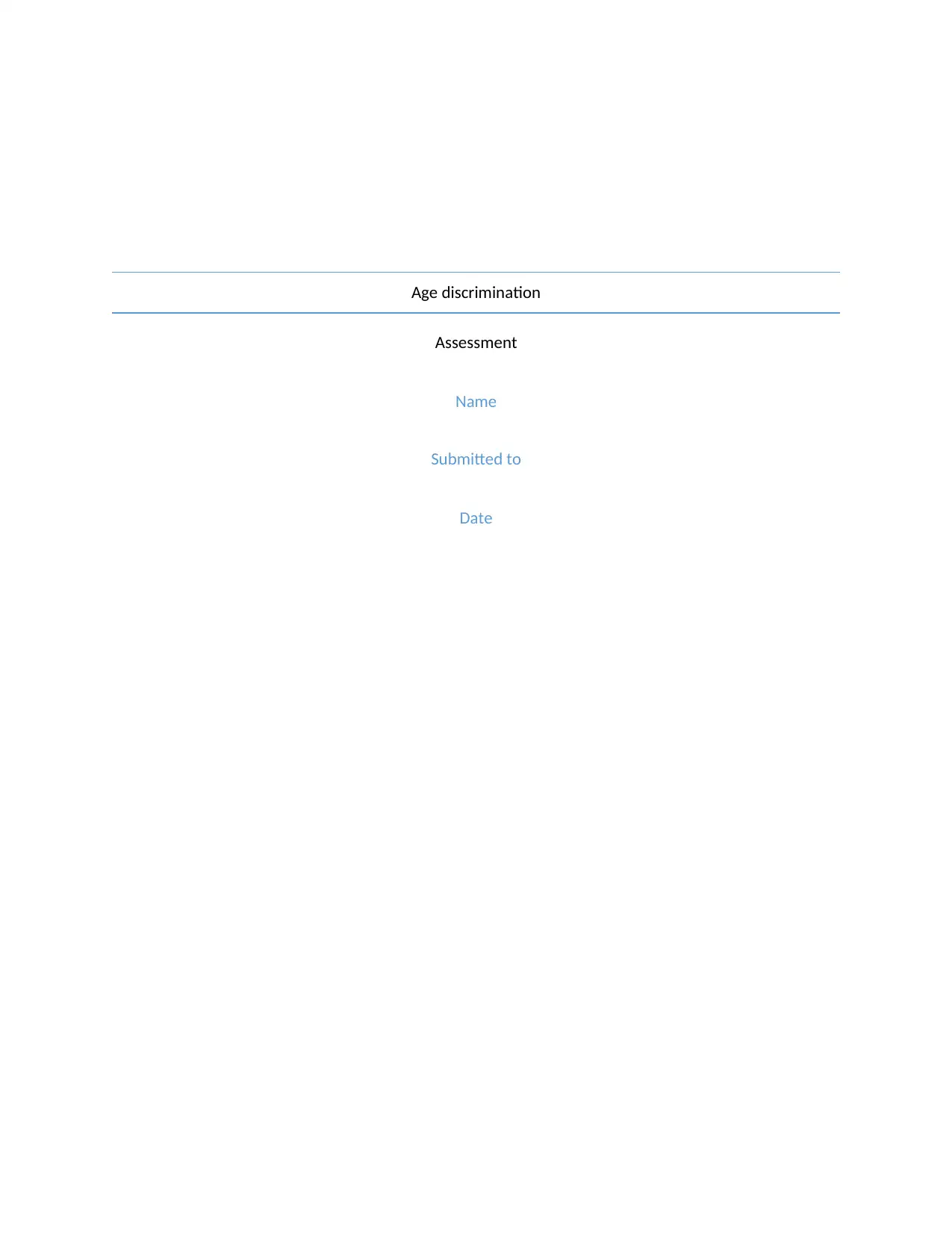
Age discrimination
Assessment
Name
Submitted to
Date
Assessment
Name
Submitted to
Date
Paraphrase This Document
Need a fresh take? Get an instant paraphrase of this document with our AI Paraphraser
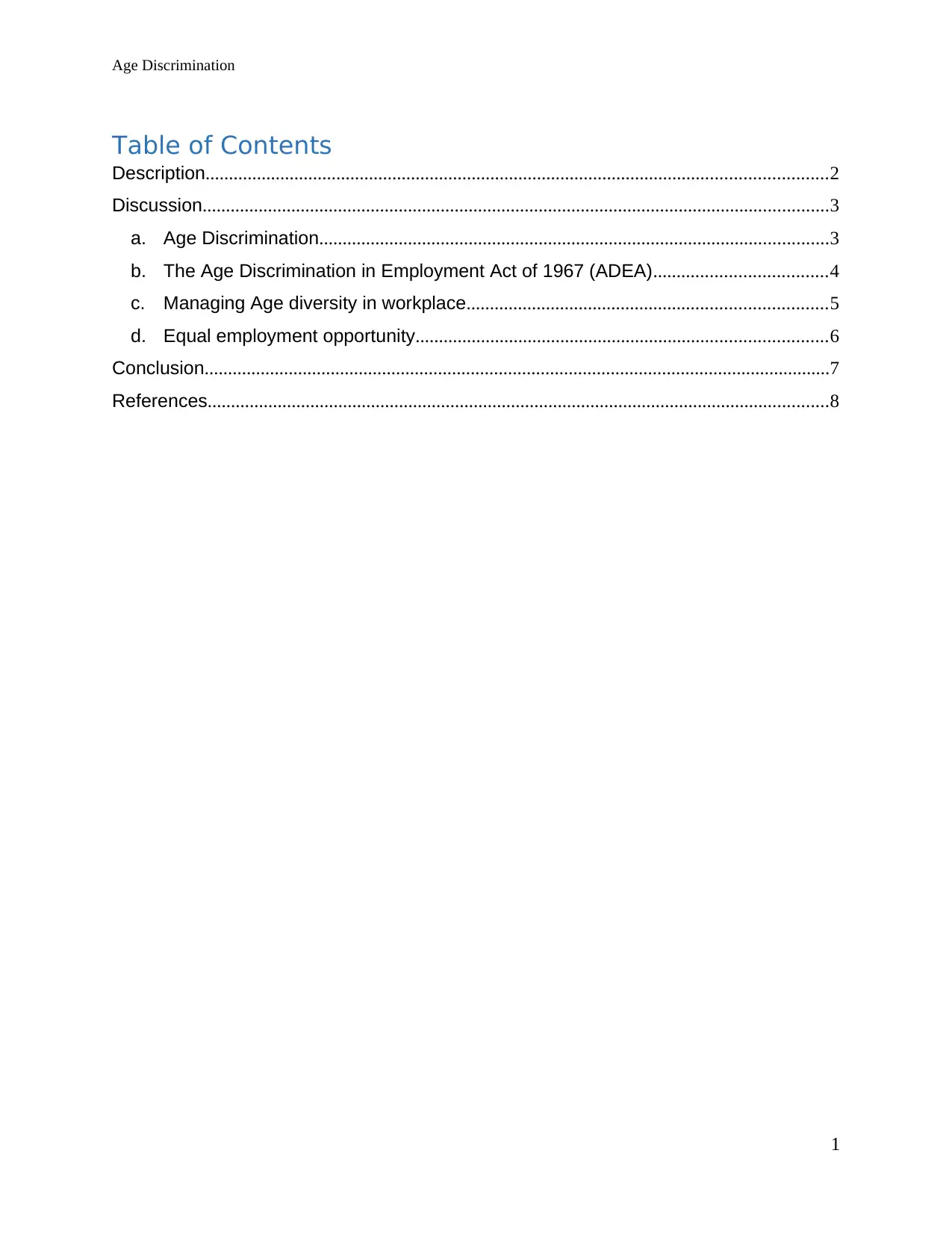
Age Discrimination
Table of Contents
Description.....................................................................................................................................2
Discussion......................................................................................................................................3
a. Age Discrimination.............................................................................................................3
b. The Age Discrimination in Employment Act of 1967 (ADEA).....................................4
c. Managing Age diversity in workplace.............................................................................5
d. Equal employment opportunity........................................................................................6
Conclusion......................................................................................................................................7
References.....................................................................................................................................8
1
Table of Contents
Description.....................................................................................................................................2
Discussion......................................................................................................................................3
a. Age Discrimination.............................................................................................................3
b. The Age Discrimination in Employment Act of 1967 (ADEA).....................................4
c. Managing Age diversity in workplace.............................................................................5
d. Equal employment opportunity........................................................................................6
Conclusion......................................................................................................................................7
References.....................................................................................................................................8
1
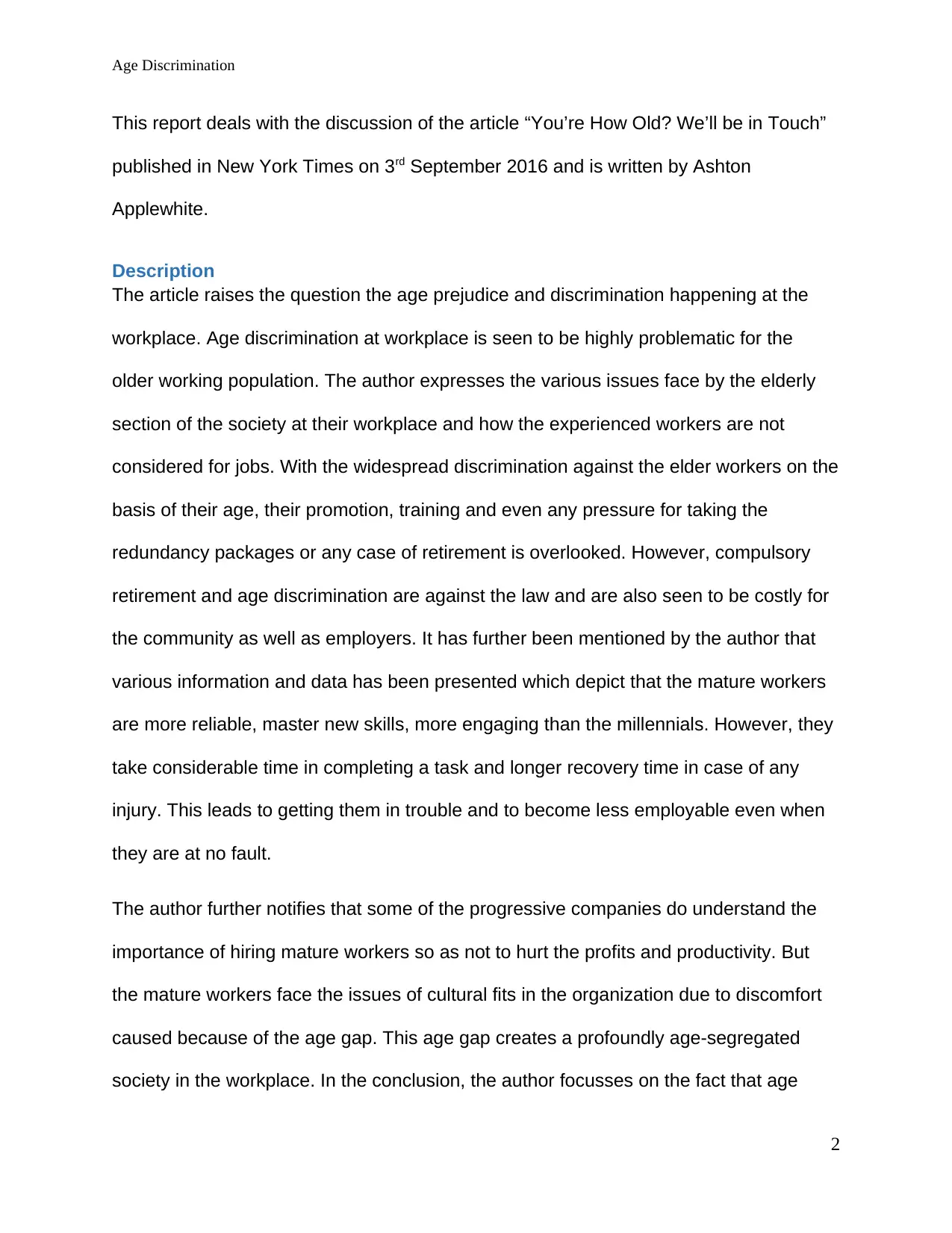
Age Discrimination
This report deals with the discussion of the article “You’re How Old? We’ll be in Touch”
published in New York Times on 3rd September 2016 and is written by Ashton
Applewhite.
Description
The article raises the question the age prejudice and discrimination happening at the
workplace. Age discrimination at workplace is seen to be highly problematic for the
older working population. The author expresses the various issues face by the elderly
section of the society at their workplace and how the experienced workers are not
considered for jobs. With the widespread discrimination against the elder workers on the
basis of their age, their promotion, training and even any pressure for taking the
redundancy packages or any case of retirement is overlooked. However, compulsory
retirement and age discrimination are against the law and are also seen to be costly for
the community as well as employers. It has further been mentioned by the author that
various information and data has been presented which depict that the mature workers
are more reliable, master new skills, more engaging than the millennials. However, they
take considerable time in completing a task and longer recovery time in case of any
injury. This leads to getting them in trouble and to become less employable even when
they are at no fault.
The author further notifies that some of the progressive companies do understand the
importance of hiring mature workers so as not to hurt the profits and productivity. But
the mature workers face the issues of cultural fits in the organization due to discomfort
caused because of the age gap. This age gap creates a profoundly age-segregated
society in the workplace. In the conclusion, the author focusses on the fact that age
2
This report deals with the discussion of the article “You’re How Old? We’ll be in Touch”
published in New York Times on 3rd September 2016 and is written by Ashton
Applewhite.
Description
The article raises the question the age prejudice and discrimination happening at the
workplace. Age discrimination at workplace is seen to be highly problematic for the
older working population. The author expresses the various issues face by the elderly
section of the society at their workplace and how the experienced workers are not
considered for jobs. With the widespread discrimination against the elder workers on the
basis of their age, their promotion, training and even any pressure for taking the
redundancy packages or any case of retirement is overlooked. However, compulsory
retirement and age discrimination are against the law and are also seen to be costly for
the community as well as employers. It has further been mentioned by the author that
various information and data has been presented which depict that the mature workers
are more reliable, master new skills, more engaging than the millennials. However, they
take considerable time in completing a task and longer recovery time in case of any
injury. This leads to getting them in trouble and to become less employable even when
they are at no fault.
The author further notifies that some of the progressive companies do understand the
importance of hiring mature workers so as not to hurt the profits and productivity. But
the mature workers face the issues of cultural fits in the organization due to discomfort
caused because of the age gap. This age gap creates a profoundly age-segregated
society in the workplace. In the conclusion, the author focusses on the fact that age
2
⊘ This is a preview!⊘
Do you want full access?
Subscribe today to unlock all pages.

Trusted by 1+ million students worldwide
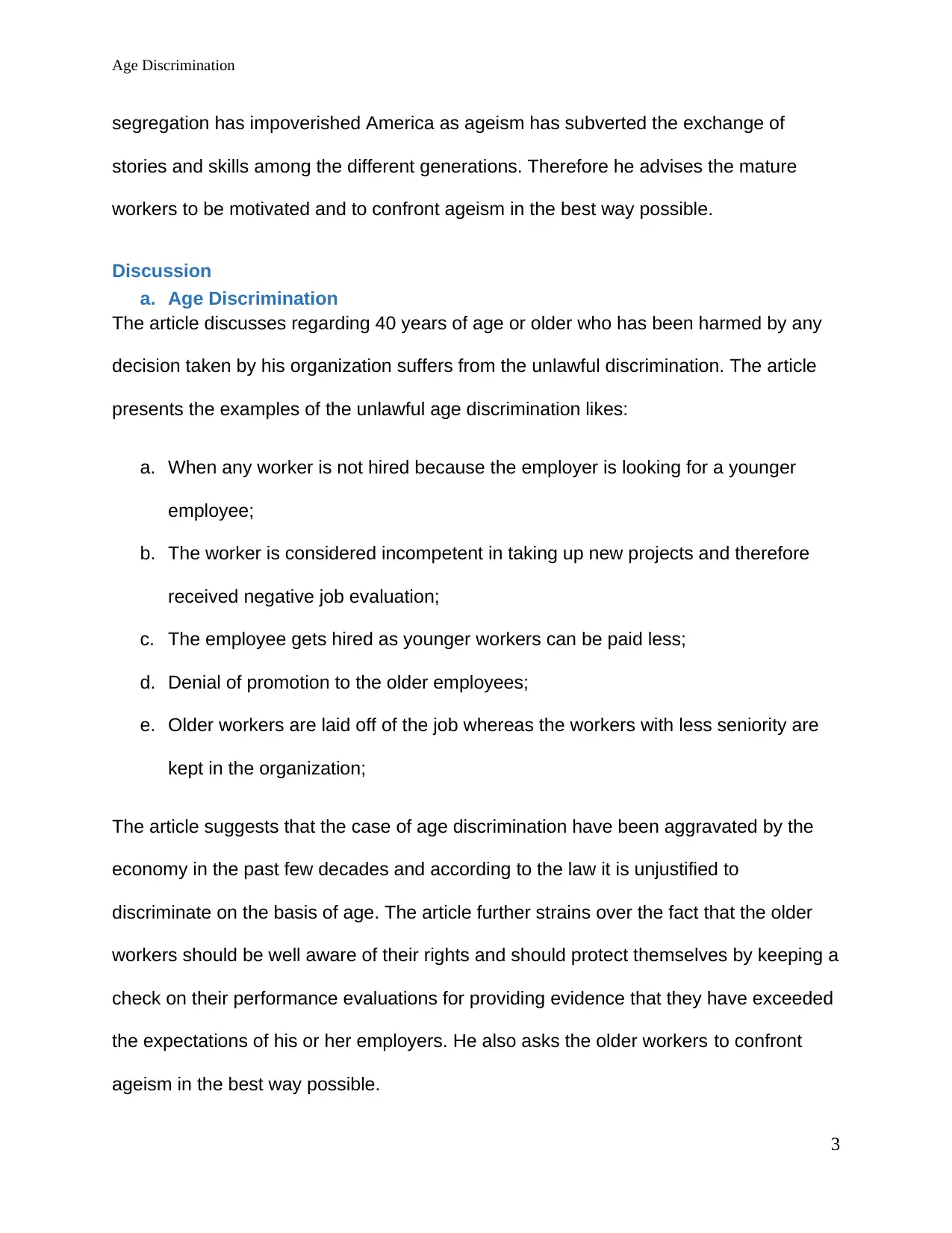
Age Discrimination
segregation has impoverished America as ageism has subverted the exchange of
stories and skills among the different generations. Therefore he advises the mature
workers to be motivated and to confront ageism in the best way possible.
Discussion
a. Age Discrimination
The article discusses regarding 40 years of age or older who has been harmed by any
decision taken by his organization suffers from the unlawful discrimination. The article
presents the examples of the unlawful age discrimination likes:
a. When any worker is not hired because the employer is looking for a younger
employee;
b. The worker is considered incompetent in taking up new projects and therefore
received negative job evaluation;
c. The employee gets hired as younger workers can be paid less;
d. Denial of promotion to the older employees;
e. Older workers are laid off of the job whereas the workers with less seniority are
kept in the organization;
The article suggests that the case of age discrimination have been aggravated by the
economy in the past few decades and according to the law it is unjustified to
discriminate on the basis of age. The article further strains over the fact that the older
workers should be well aware of their rights and should protect themselves by keeping a
check on their performance evaluations for providing evidence that they have exceeded
the expectations of his or her employers. He also asks the older workers to confront
ageism in the best way possible.
3
segregation has impoverished America as ageism has subverted the exchange of
stories and skills among the different generations. Therefore he advises the mature
workers to be motivated and to confront ageism in the best way possible.
Discussion
a. Age Discrimination
The article discusses regarding 40 years of age or older who has been harmed by any
decision taken by his organization suffers from the unlawful discrimination. The article
presents the examples of the unlawful age discrimination likes:
a. When any worker is not hired because the employer is looking for a younger
employee;
b. The worker is considered incompetent in taking up new projects and therefore
received negative job evaluation;
c. The employee gets hired as younger workers can be paid less;
d. Denial of promotion to the older employees;
e. Older workers are laid off of the job whereas the workers with less seniority are
kept in the organization;
The article suggests that the case of age discrimination have been aggravated by the
economy in the past few decades and according to the law it is unjustified to
discriminate on the basis of age. The article further strains over the fact that the older
workers should be well aware of their rights and should protect themselves by keeping a
check on their performance evaluations for providing evidence that they have exceeded
the expectations of his or her employers. He also asks the older workers to confront
ageism in the best way possible.
3
Paraphrase This Document
Need a fresh take? Get an instant paraphrase of this document with our AI Paraphraser
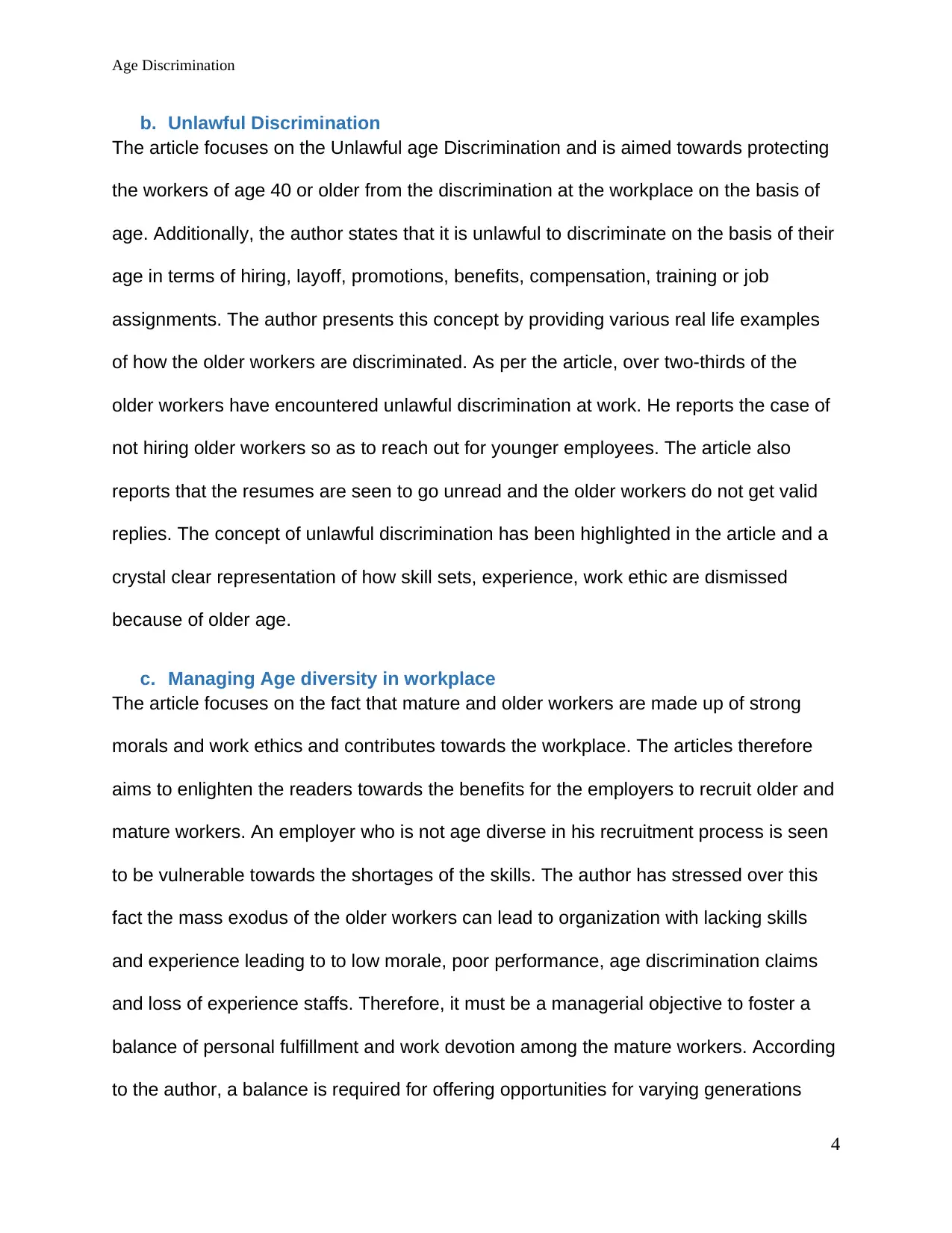
Age Discrimination
b. Unlawful Discrimination
The article focuses on the Unlawful age Discrimination and is aimed towards protecting
the workers of age 40 or older from the discrimination at the workplace on the basis of
age. Additionally, the author states that it is unlawful to discriminate on the basis of their
age in terms of hiring, layoff, promotions, benefits, compensation, training or job
assignments. The author presents this concept by providing various real life examples
of how the older workers are discriminated. As per the article, over two-thirds of the
older workers have encountered unlawful discrimination at work. He reports the case of
not hiring older workers so as to reach out for younger employees. The article also
reports that the resumes are seen to go unread and the older workers do not get valid
replies. The concept of unlawful discrimination has been highlighted in the article and a
crystal clear representation of how skill sets, experience, work ethic are dismissed
because of older age.
c. Managing Age diversity in workplace
The article focuses on the fact that mature and older workers are made up of strong
morals and work ethics and contributes towards the workplace. The articles therefore
aims to enlighten the readers towards the benefits for the employers to recruit older and
mature workers. An employer who is not age diverse in his recruitment process is seen
to be vulnerable towards the shortages of the skills. The author has stressed over this
fact the mass exodus of the older workers can lead to organization with lacking skills
and experience leading to to low morale, poor performance, age discrimination claims
and loss of experience staffs. Therefore, it must be a managerial objective to foster a
balance of personal fulfillment and work devotion among the mature workers. According
to the author, a balance is required for offering opportunities for varying generations
4
b. Unlawful Discrimination
The article focuses on the Unlawful age Discrimination and is aimed towards protecting
the workers of age 40 or older from the discrimination at the workplace on the basis of
age. Additionally, the author states that it is unlawful to discriminate on the basis of their
age in terms of hiring, layoff, promotions, benefits, compensation, training or job
assignments. The author presents this concept by providing various real life examples
of how the older workers are discriminated. As per the article, over two-thirds of the
older workers have encountered unlawful discrimination at work. He reports the case of
not hiring older workers so as to reach out for younger employees. The article also
reports that the resumes are seen to go unread and the older workers do not get valid
replies. The concept of unlawful discrimination has been highlighted in the article and a
crystal clear representation of how skill sets, experience, work ethic are dismissed
because of older age.
c. Managing Age diversity in workplace
The article focuses on the fact that mature and older workers are made up of strong
morals and work ethics and contributes towards the workplace. The articles therefore
aims to enlighten the readers towards the benefits for the employers to recruit older and
mature workers. An employer who is not age diverse in his recruitment process is seen
to be vulnerable towards the shortages of the skills. The author has stressed over this
fact the mass exodus of the older workers can lead to organization with lacking skills
and experience leading to to low morale, poor performance, age discrimination claims
and loss of experience staffs. Therefore, it must be a managerial objective to foster a
balance of personal fulfillment and work devotion among the mature workers. According
to the author, a balance is required for offering opportunities for varying generations
4
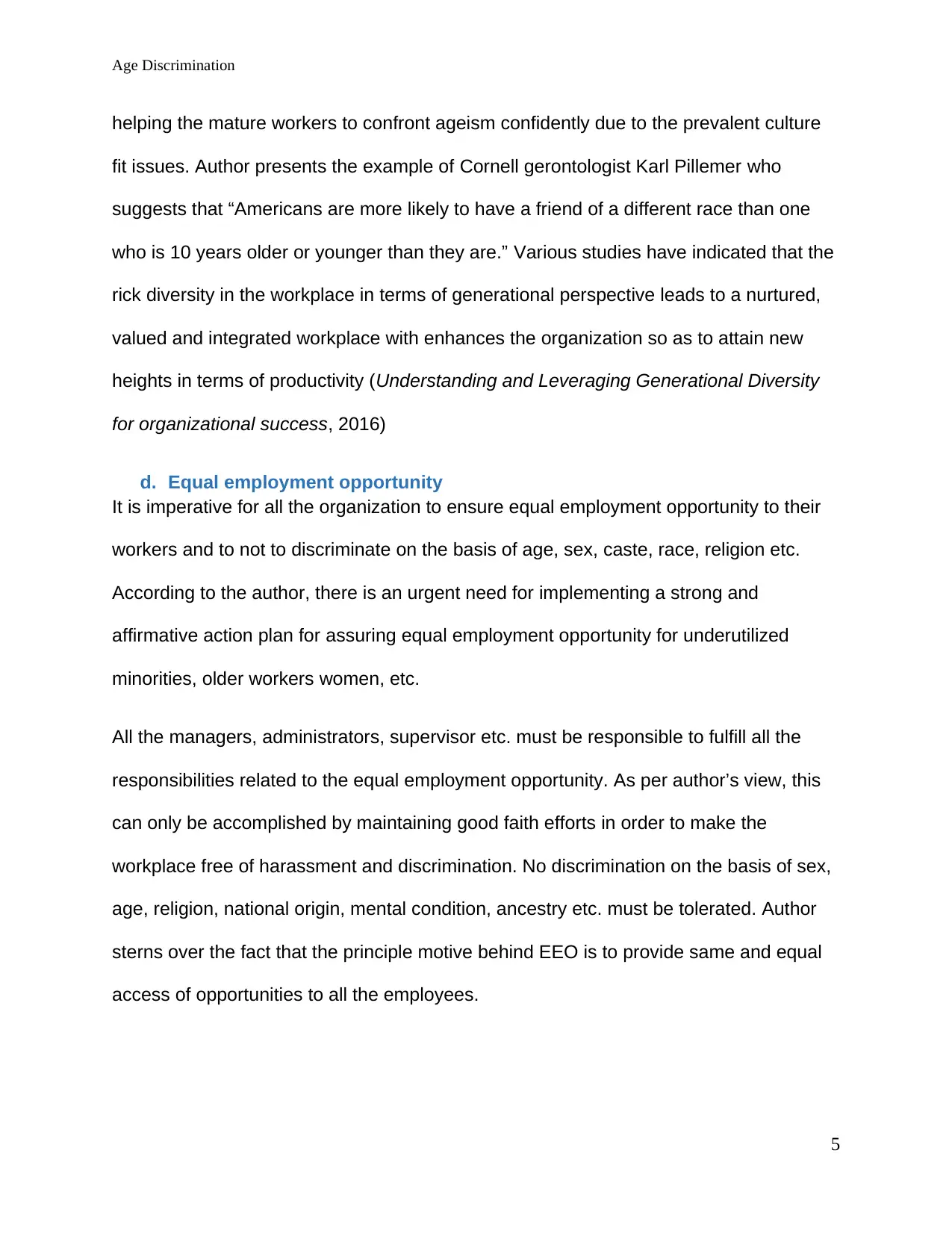
Age Discrimination
helping the mature workers to confront ageism confidently due to the prevalent culture
fit issues. Author presents the example of Cornell gerontologist Karl Pillemer who
suggests that “Americans are more likely to have a friend of a different race than one
who is 10 years older or younger than they are.” Various studies have indicated that the
rick diversity in the workplace in terms of generational perspective leads to a nurtured,
valued and integrated workplace with enhances the organization so as to attain new
heights in terms of productivity (Understanding and Leveraging Generational Diversity
for organizational success, 2016)
d. Equal employment opportunity
It is imperative for all the organization to ensure equal employment opportunity to their
workers and to not to discriminate on the basis of age, sex, caste, race, religion etc.
According to the author, there is an urgent need for implementing a strong and
affirmative action plan for assuring equal employment opportunity for underutilized
minorities, older workers women, etc.
All the managers, administrators, supervisor etc. must be responsible to fulfill all the
responsibilities related to the equal employment opportunity. As per author’s view, this
can only be accomplished by maintaining good faith efforts in order to make the
workplace free of harassment and discrimination. No discrimination on the basis of sex,
age, religion, national origin, mental condition, ancestry etc. must be tolerated. Author
sterns over the fact that the principle motive behind EEO is to provide same and equal
access of opportunities to all the employees.
5
helping the mature workers to confront ageism confidently due to the prevalent culture
fit issues. Author presents the example of Cornell gerontologist Karl Pillemer who
suggests that “Americans are more likely to have a friend of a different race than one
who is 10 years older or younger than they are.” Various studies have indicated that the
rick diversity in the workplace in terms of generational perspective leads to a nurtured,
valued and integrated workplace with enhances the organization so as to attain new
heights in terms of productivity (Understanding and Leveraging Generational Diversity
for organizational success, 2016)
d. Equal employment opportunity
It is imperative for all the organization to ensure equal employment opportunity to their
workers and to not to discriminate on the basis of age, sex, caste, race, religion etc.
According to the author, there is an urgent need for implementing a strong and
affirmative action plan for assuring equal employment opportunity for underutilized
minorities, older workers women, etc.
All the managers, administrators, supervisor etc. must be responsible to fulfill all the
responsibilities related to the equal employment opportunity. As per author’s view, this
can only be accomplished by maintaining good faith efforts in order to make the
workplace free of harassment and discrimination. No discrimination on the basis of sex,
age, religion, national origin, mental condition, ancestry etc. must be tolerated. Author
sterns over the fact that the principle motive behind EEO is to provide same and equal
access of opportunities to all the employees.
5
⊘ This is a preview!⊘
Do you want full access?
Subscribe today to unlock all pages.

Trusted by 1+ million students worldwide
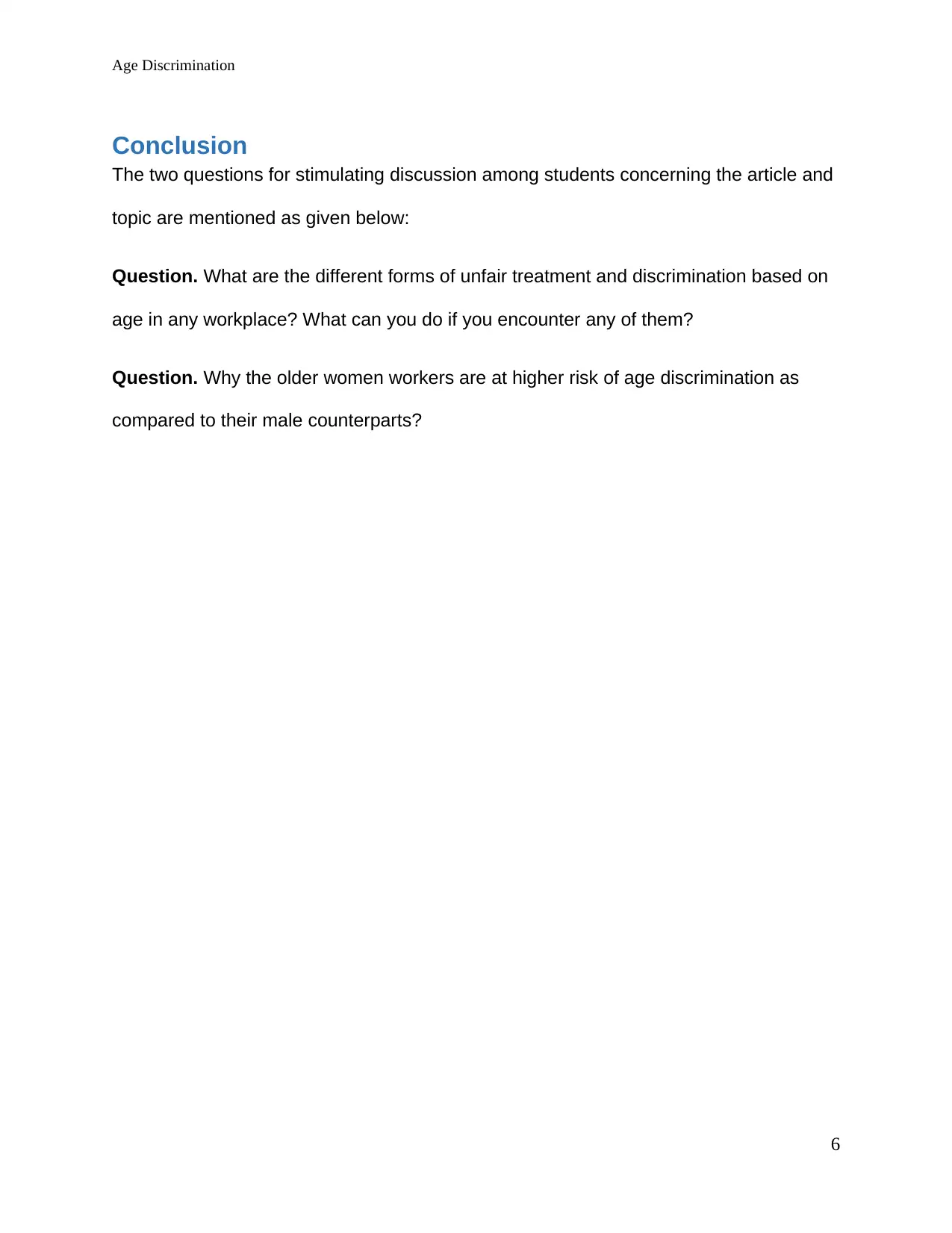
Age Discrimination
Conclusion
The two questions for stimulating discussion among students concerning the article and
topic are mentioned as given below:
Question. What are the different forms of unfair treatment and discrimination based on
age in any workplace? What can you do if you encounter any of them?
Question. Why the older women workers are at higher risk of age discrimination as
compared to their male counterparts?
6
Conclusion
The two questions for stimulating discussion among students concerning the article and
topic are mentioned as given below:
Question. What are the different forms of unfair treatment and discrimination based on
age in any workplace? What can you do if you encounter any of them?
Question. Why the older women workers are at higher risk of age discrimination as
compared to their male counterparts?
6
Paraphrase This Document
Need a fresh take? Get an instant paraphrase of this document with our AI Paraphraser
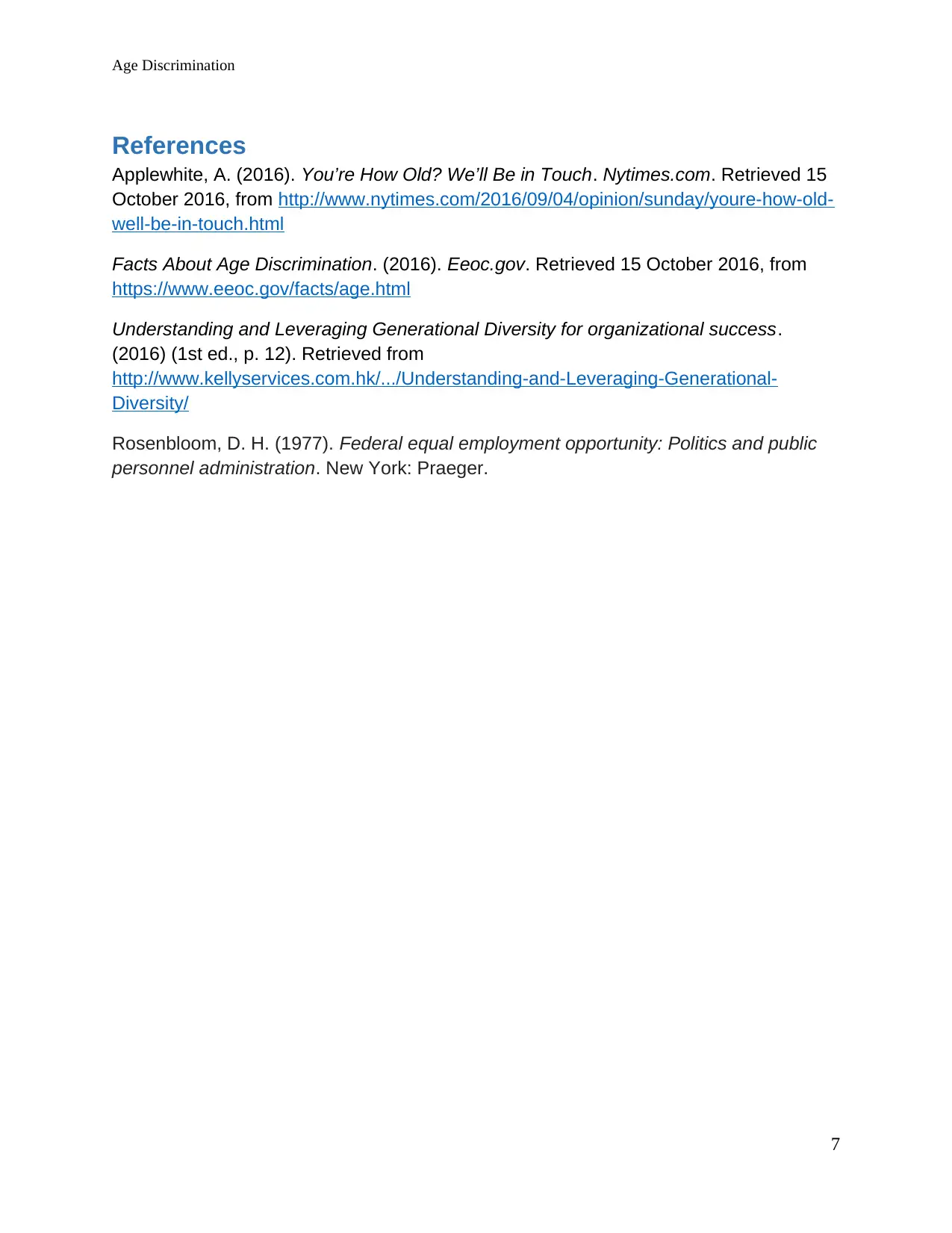
Age Discrimination
References
Applewhite, A. (2016). You’re How Old? We’ll Be in Touch. Nytimes.com. Retrieved 15
October 2016, from http://www.nytimes.com/2016/09/04/opinion/sunday/youre-how-old-
well-be-in-touch.html
Facts About Age Discrimination. (2016). Eeoc.gov. Retrieved 15 October 2016, from
https://www.eeoc.gov/facts/age.html
Understanding and Leveraging Generational Diversity for organizational success.
(2016) (1st ed., p. 12). Retrieved from
http://www.kellyservices.com.hk/.../Understanding-and-Leveraging-Generational-
Diversity/
Rosenbloom, D. H. (1977). Federal equal employment opportunity: Politics and public
personnel administration. New York: Praeger.
7
References
Applewhite, A. (2016). You’re How Old? We’ll Be in Touch. Nytimes.com. Retrieved 15
October 2016, from http://www.nytimes.com/2016/09/04/opinion/sunday/youre-how-old-
well-be-in-touch.html
Facts About Age Discrimination. (2016). Eeoc.gov. Retrieved 15 October 2016, from
https://www.eeoc.gov/facts/age.html
Understanding and Leveraging Generational Diversity for organizational success.
(2016) (1st ed., p. 12). Retrieved from
http://www.kellyservices.com.hk/.../Understanding-and-Leveraging-Generational-
Diversity/
Rosenbloom, D. H. (1977). Federal equal employment opportunity: Politics and public
personnel administration. New York: Praeger.
7
1 out of 8
Related Documents
Your All-in-One AI-Powered Toolkit for Academic Success.
+13062052269
info@desklib.com
Available 24*7 on WhatsApp / Email
![[object Object]](/_next/static/media/star-bottom.7253800d.svg)
Unlock your academic potential
Copyright © 2020–2025 A2Z Services. All Rights Reserved. Developed and managed by ZUCOL.





